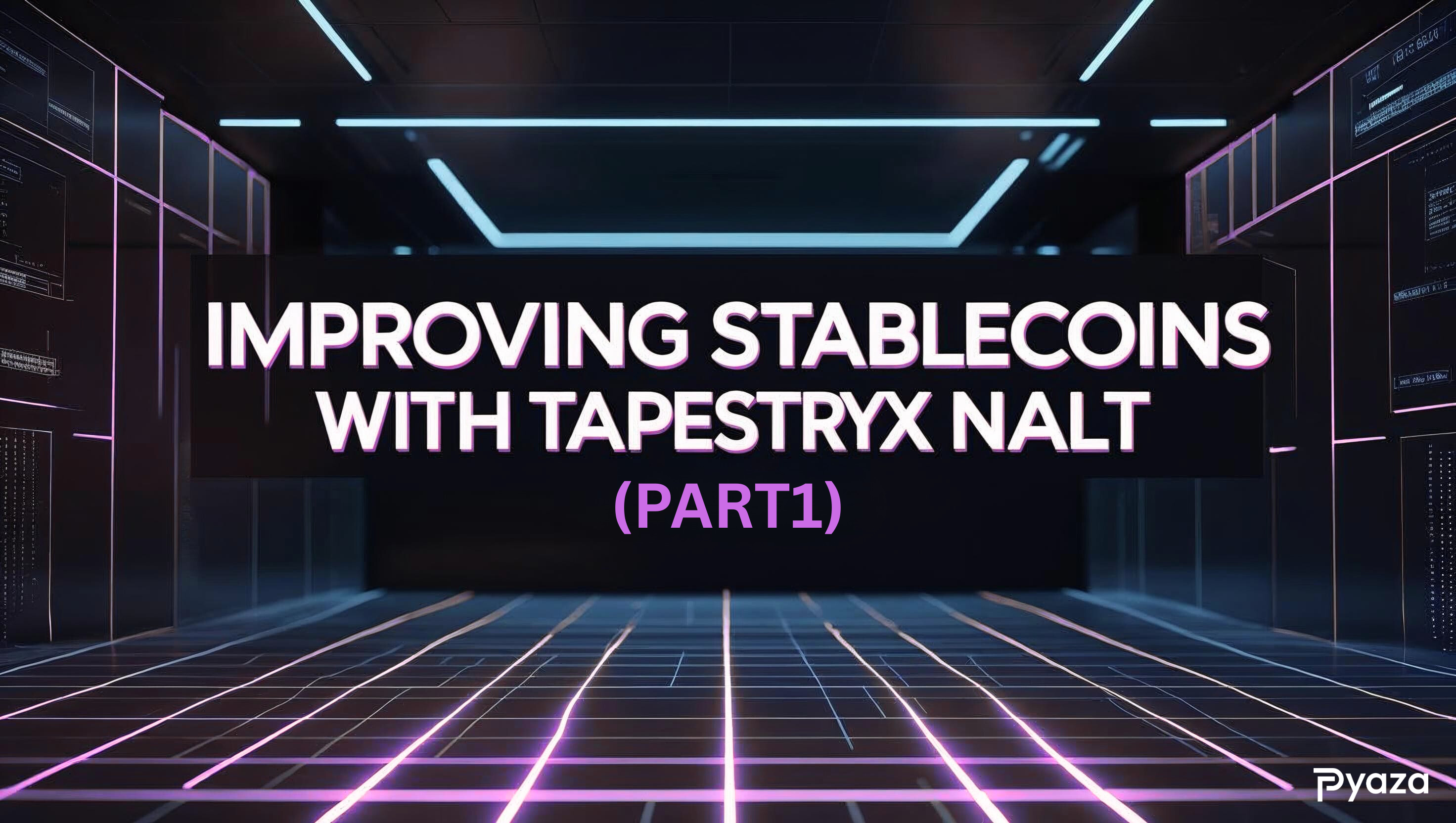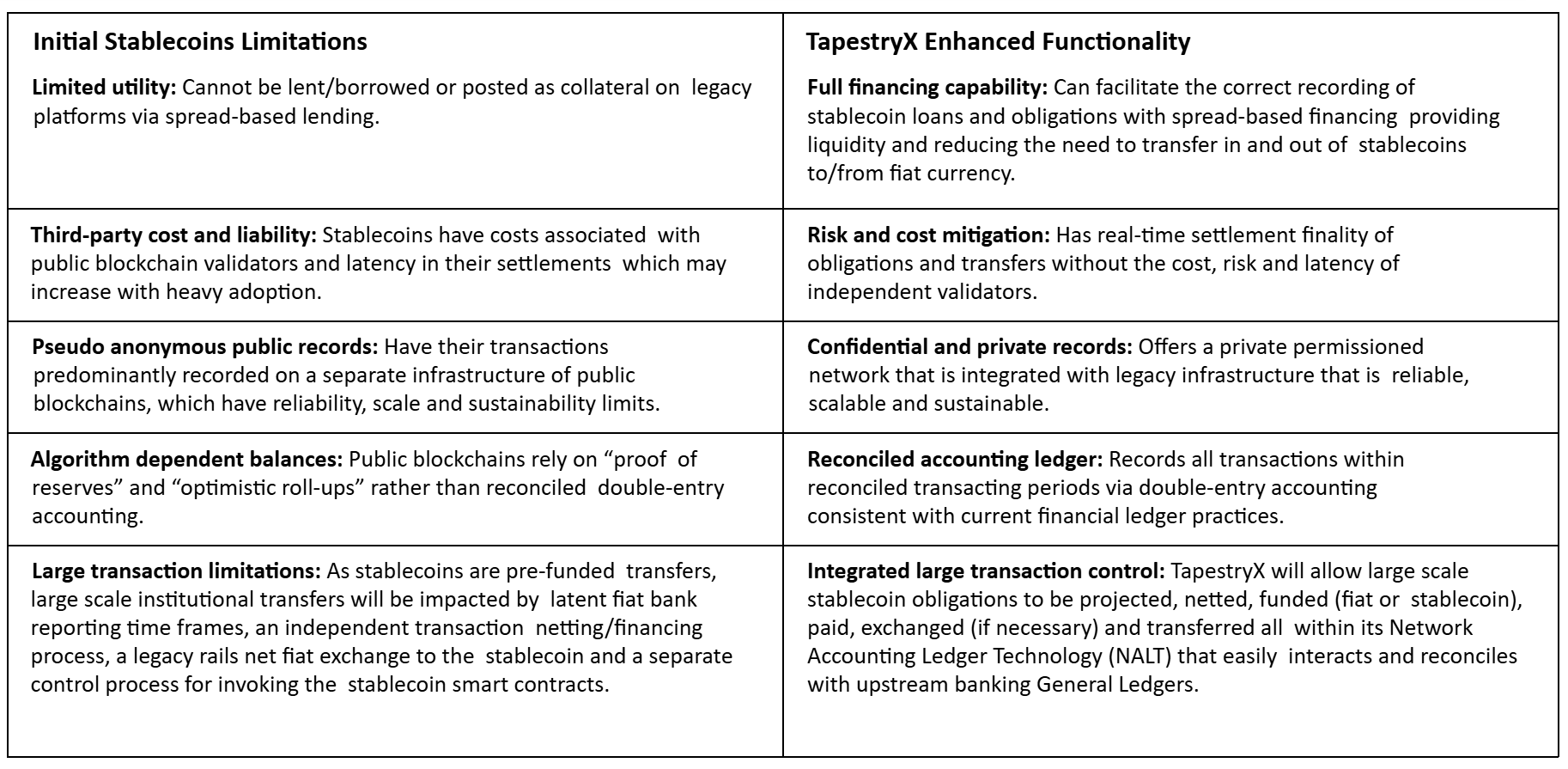Improving Stablecoins with TapestryX NAL (Part1)
TapestryX, new Networked Accounting Ledger Tech, enables conventional spread-based borrowing/lending to unleash the full potential of stablecoins and tokenized assets

William Pallumbo
Deployment Manager - TapestryX
Introduction
TapestryX, new Networked Accounting Ledger Tech, enables conventional spread-based borrowing/lending to unleash the full potential of stablecoins and tokenized assets
Forthcoming regulatory clarity in the US has made Stablecoins a major focus for digital asset markets, with commercial benefits for issuers, transacting parties, holders.
Stablecoins currently only support fully funded position transfers, mostly to move collateral required for DeFi/Crypto activities, and some cross-border payments.
DLT limitations* hamper the ability to support conventional borrowing/lending by banks and non-bank entities.
The International Securities Services Association (ISSA) has identified key challenges and necessary improvements for the digital/tokenized asset market. Liquidity of Tokenized Cash/Securities is the most pressing issue.
TapestryX, a new NAL can significantly improve Stablecoin utility and adoption, addressing the top challenges for three types of participants in the market:
“Top of Supply Chain” network owners (Amazon, Walmart, DoD, etc) - seeking efficiencies
Banking Networks - Globals, Correspondents, US Regionals - to avoid disintermediation
Stablecoin Issuers - seeking to enhance and grow their platforms
* DLTs generally cannot record future obligations on-chain, which limits supply chain utility as payables/receivables are not supported natively, likewise traditional borrowing & lending is also inhibited.

Initial Stablecoins are better for consumers, merchants and issuers
Stablecoin Advantages
Money transfers (fiat-stable-fiat) settle in 15-50 mins
Consumers and merchants incur less fees than normal payment rails – see current cost breakdown
Stablecoins backing (cash and cash equivalents) earns interest for issuers, some of which can be passed to the holders
Stablecoins can be staked via DeFi protocols to earn additional returns for stablecoin holders, but this incurs the cost and risk of other public blockchain protocols
Current Payments Cost Breakdown
Every time you tap a card, three players take a cut:
Visa and Mastercard take 0.14% (“network fees”)
Stripe, Fiserv, etc. take 0.40% (“processing fees”)
Biggest part? 1.8% goes to issuing banks - called “interchange fee”.
Last year:
Visa & Mastercard: charged $19 billion - Processors: $30 billion
Banks: $143 billion
These are the costs that the likes of Amazon and Walmart will avoid by issuing their own Stablecoin
ISSA DLT in the Real World 2025 – Summary and our Insight
The ISSA’s survey drew several key conclusions for digital assets related to stablecoins. (see appendix)
Improving Liquidity has come to the forefront of the industry agenda
From overnight to intraday financing: 85% of respondents see intraday liquidity as the key business need of DLT and digital assets
So what is hampering Liquidity?
Regulatory constraints have limited adoption (this will change)
DLTs structurally cannot record future obligations on-chain. This limits traditional financing activities required for liquidity in capital markets, including stablecoins.
Note – Smart contracts can record future obligations, but they hinder netting and accounting activities.
Stablecoin limitations that TapestryX can overcome and augment

Current and Prospective Issuers of Stablecoins
Current Stablecoins
USDT (Tether USD)
CNHt (Tether Yuan)
MXNt (Tether Peso)
USDC (Circle USD)
EURC (Circle Eur)
BUSD (USD Coin)
TUSD (True US Coin)
Eure (Euro Coin)
JPYC (JPY Coin)
PYUSD (PayPal Coin)
Future Stablecoin Issuers
Visa and Mastercard
Shopify
Stripe
Fiserv
Robinhood
Goldman Sachs
JPMorgan
TelegramX
Charles Schwab
Amazon
Walmart
Click the button below to continue to Part 2, where we dive deeper into stablecoin regulation, BIS critiques, and how TapestryX enables a next-generation B2B stablecoin network.
Download the Pyaza app to follow our coverage, connect with the team, and get involved in upcoming creator campaigns.